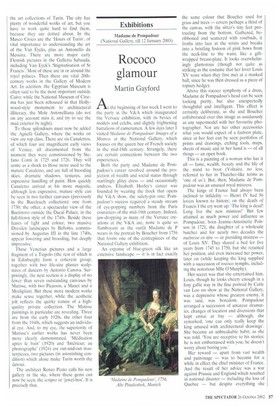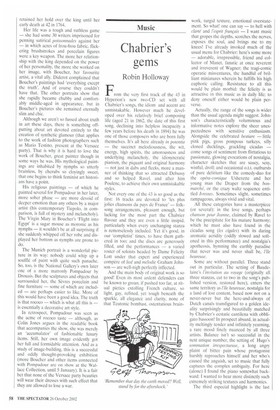Exhibitions
Madame de Pompadour (National Gallery, till 12 January 2003)
Rococo glamour
Martin Gayford
A, the beginning of last week I went to the party at the V&A which inaugurated the Versace exhibition, with its bevies of models and celcbs, and slightly frightening battalions of cameramen. A few days later I visited Madame de Pompadour: Images of a Mistress at the National Gallery, which focuses on the queen bee of French society in the mid-18th century. Strangely, there are certain connections between the two experiences.
Both the party and Madame de Pompadour's career revolved around the projection of wealth and social status through startlingly glitzy dress — and occasionally undress. Elizabeth Hurley's career was founded by wearing the frock that opens the V&A show, the safety-pin one; Pompadour's success required a steady stream of eye-popping numbers from the Paris couturiers of the mid-18th century. Indeed, jaw-dropping as many of the Versace creations at the V&A are, none is quite so flamboyant as the outfit Madame de P wears in the portrait by Boucher from 1756 that forms one of the centrepieces of the National Gallery exhibition.
An expanse of blue-green silk like an extensive landscape — it is in fact exactly the same colour that Boucher used for grass and trees — covers perhaps a third of the canvas, with the sitter's tiny feet protruding from the bottom. Gathered, beribboned and scattered with rosebuds, it froths into lace at the wrists and breaks into a bristling festoon of pink bows from the neck-line to the waist, like a giftwrapped breast-plate. It looks overwhelmingly glamorous (though not quite as striking as the costume that her lover Louis XV wore when they first met at a masked ball, since he was then dressed as a piece of topiary hedge).
Above this rococo symphony of a dress, Madame de Pompadour's head can be seen looking pretty, but also unexpectedly thoughtful and intelligent. This effect is certainly deliberate, as she and Boucher collaborated over this image as assiduously as any supermodel with her favourite photographer. Nor are her other accessories what you would expect of a fashion plate, since at her feet can be seen portfolios of prints and drawings, etching tools, maps, sheets of music and in her hand is — of all things — an open book.
This is a painting of a woman who has it all — fame, wealth, beauty and the life of the mind to boot (Voltaire, no less, referred to her in Thatcher-like terms as 'one of us'). But, then, Madame de Pompadour was an unusual royal mistress.
The kings of France had always been inclined to infidelity — Henri IV had 56 lovers known to history; on the death of Francis I the cry went up: 'The king is dead! Long live the new mistress!' But few attained as much power and influence as Pompadour, born Jeanne-Antoinette Poisson in 1721, the daughter of a wholesale butcher and for nearly two decades the maitresse en titre — or presiding mistress — of Louis XV. They shared a bed for five years from 1745 to 1750, but she retained her position, and even increased her power, later on (while keeping the king supplied with a succession of rococo nymphs, including the notorious Mlle O'Murphy).
Her secret was that she entertained him. Louis, though he looks cheery enough in a foxy gallic way in the fine portrait by Carle van Loo on show at the National Gallery, was a depressive whose greatest enemy, it was said, was boredom. Pompadour arranged a succession of amateur dramatics, changes of location and diversions that kept ennui at bay — although, she remarked, 'one can only really keep the king amused with architectural drawings'. She became an unbreakable habit; as she was told. 'You are receptive to his stories; he is not embarrassed with you; he doesn't worry about boring you.'
Her reward — apart from vast wealth and patronage — was to become for a while in effect the chief minister of France. And the result of her advice was a war against Prussia and England which resulted in national disaster — including the loss of Quebec — but despite everything she retained her hold over the king until her early death at 42 in 1764. Her life was a tough and ruthless game — she had some 30 writers imprisoned for penning satirical poissonnades against her — in which acres of frou-frou fabric, flickering brushstrokes and porcelain figures were a key weapon. The more her relationship with the king depended on the power of her personality, the more she worked on her image, with Boucher, her favourite artist, a vital ally. Diderot complained that Boucher's paintings had 'everything except the truth'. And of course they couldn't have that. The other portraits show that she rapidly became chubby and comfortably middle-aged in appearance, but in Boucher's pictures she remained eternally slim and chic. Although we aren't so fussed about truth in art these days, there is something offputting about art devoted entirely to the creation of synthetic glamour (that applies to the work of fashion photographers such as Mario Testino, present at the Versace party). That is why it is hard to love the work of Boucher, great painter though in some ways he was. His mythological paintings are inhabited by nymphs so utterly brainless, by cherubs so cloyingly sweet, that one begins to think feminist art historians have a point. His religious paintings — of which he painted several for Pompadour in her later, more sober phase — are more devoid of deeper emotion than any others by a major artist (his contemporary Tiepolo, in comparison, is full of mystery and melancholy). The Virgin Mary in Boucher's 'Flight into Egypt' is a sugar mouse as moronic as his nymphs — it wouldn't be at all surprising if she suddenly whipped off her robe and displayed her bottom as nymphs are prone to do. The Munich portrait is a wonderful picture in its way: nobody could whip up a soufflé of paint with quite such panache. So, too, is the National Gallery's own later one of a more matronly Pompadour by Drouais, But the sculptures and objects that surrounded her, the Sevres porcelain and fine furniture — some of which are included — are perhaps easier to like. More of this would have been a good idea. The truth is that rococo — which is what all this is — is essentially a decorative art style. In retrospect, Pompadour was seen as the acme of rococo taste — although, as Colin Jones argues in the readable book that accompanies the show, she was merely an 'accumulator' of fashionable luxury items. Still, her own image evidently got her full and formidable attention. And as a study of image-building, this is a successful and oddly thought-provoking exhibition (more Boucher and other items connected with Pompadour are on show at the Wallace Collection. until 5 January). It is a fair bet that none of the Versace party beauties will wear their dresses with such effect that they are allowed to lose a war.



















































































 Previous page
Previous page